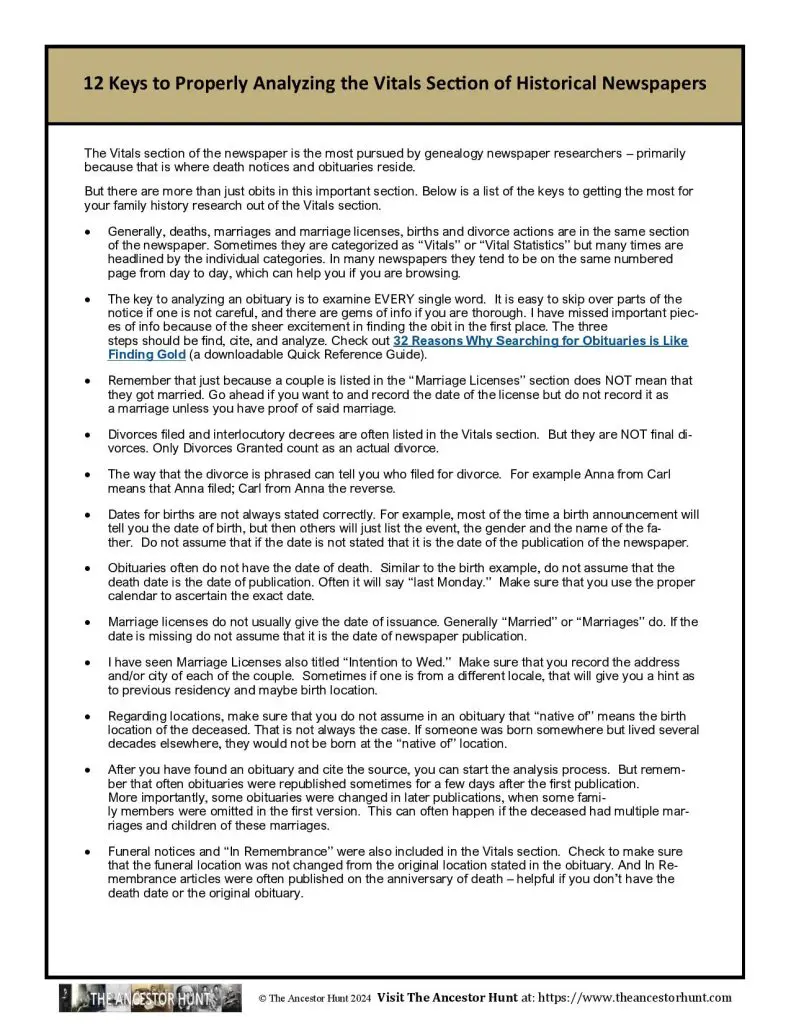
(This page's most recent update is August 2024)
The Vitals section of the newspaper is generally the most pursued by genealogy newspaper researchers – primarily because that is where death notices and obituaries reside.
But there are more than just obits in this important section. Below is a list of the keys to getting the most for your family history research out of the contents of this newspaper section.
- Generally, deaths, marriages and marriage licenses, births, and divorce actions are in the same section of the newspaper. Sometimes they are categorized as “Vitals” or “Vital Statistics” but many times are headlined by the individual categories. In many newspapers, they tend to be on the same numbered page from day to day, which can help you if you are browsing.
- The key to analyzing an obituary is to examine EVERY single word. It is easy to skip over parts of the notice if one is not careful, and there are gems of info if you are thorough. I have missed important pieces of info because of the sheer excitement in finding the obit in the first place. The three steps should be to find, cite, and analyze. Check out 32 Reasons Why Searching for Obituaries is Like Finding Gold (a downloadable Quick Reference Guide).
- Remember that just because a couple is listed in the “Marriage Licenses” section does NOT mean that they got married. Go ahead if you want to and record the date of the license but do not record it as a marriage unless you have proof of said marriage.
- Divorces filed and interlocutory decrees are often listed in the Vitals section. But they are NOT final divorces. Only Divorces Granted count as an actual divorce.
- The way that the divorce is phrased can tell you who filed for divorce. For example, Anna from Carl means that Anna filed; Carl from Anna the reverse.
- Dates for births are not always stated correctly. For example, most of the time a birth announcement will tell you the date of birth, but then others will just list the event, the gender, and the name of the father. Do not assume that if the date is not stated it is the date of the publication of the newspaper.
- Obituaries often do not have the date of death. Similar to the birth example, do not assume that the death date is the date of publication. Often it will say “last Monday.” Make sure that you use the proper calendar to ascertain the exact date.
- Marriage licenses do not usually give the date of issuance. Generally “Married” or “Marriages” do. If the date is missing, do not assume it is the newspaper publication date.
- I have seen Marriage Licenses also titled “Intention to Wed.” Make sure that you record the address and/or city of each of the couple. Sometimes if one is from a different locale, that will give you a hint as to previous residency and maybe birth location.
- Regarding locations, make sure that you do not assume in an obituary that “native of” means the birth location of the deceased. That is not always the case. If someone was born somewhere but lived several decades elsewhere, they would not be born at the “native of” location.
- After you have found an obituary and cited the source, you can start the analysis process. But remember that often obituaries were republished sometimes for a few days after the first publication. More importantly, some obituaries were changed in later publications, when some family members were omitted in the first version. This can often happen if the deceased had multiple marriages and children of these marriages.
- Funeral notices and “In Remembrance” were also included in the Vitals section. Check to make sure that the funeral location was not changed from the original location stated in the obituary. In Remembrance articles were often published on the anniversary of death – helpful if you don’t have the death date or the original obituary.
Download the Quicksheet PDF
To obtain the one-page Quicksheet pdf for easy reference on how to properly analyze material in the Vitals section, you can download it by clicking on the Download button below:
For all the previously published Quick Reference Guides, click on QuickSheets.
Genealogy QuickSheets – Frequently Asked Questions
Quicksheets are also known as Quick Reference Guides. They are generally a one or two page PDF that is downloadable. A few QuickSheets are as large as a five page PDF.
Every QuickSheet is in a specific post on The Ancestor Hunt website. Just bring up the post, and at the bottom of the page is a big brown Download button that allows you to view and/or download the PDF when clicked.
There are over 80 QuickSheets.
Here are links to the 10 Most Popular:
- 100 Best Free Online Genealogy Websites
- Beyond the Search Engine: Using Google Databases for Genealogy Research
- 64 Genealogy Items to Collect from Your Home
- United States Genealogical and Historical Societies
- 24 Places Where You Can Find Your Ancestors Occupation
- 13 Types of Genealogical Information You Can Find in Old Yearbooks
- 16 Places Where You Can Find Genealogy and Family History Books
- Easy Cousin Relationship Chart
- The Easiest Way to Find Every Historical Newspaper in America
- The Best Way to Find 20% More Pertinent Newspaper Articles Online
Yes! You can view or download as many as you wish.